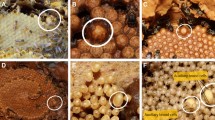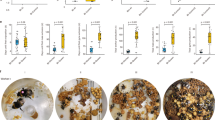Summary
Male parentage in the bumble bee Bombus melanopygus was estimated using a colour dimorphism as a genetic marker. 1491 males from 17 colonies were classified. 19% of the males originated from the workers while the queens were alive; after their death workers continued to lay eggs, thus in total 39% of the males were worker-produced. The sex ratio of reproductive was male biased (1:6.9, F:M) as well as the investiment ratio (1:2.7). The sex and investment ratios of reproductives produced by the queens were also male biased (1:4.4 and 1:1.7) respectively). There was no significant correlation between the proportion of males produced by the workers while the queens were alive and either colony size or queen lifespan. The queens were, on average, significantly more related to the reproductive brood (r=0.469) than were the workers as a group (r=0.380). The average ‘reproductive success’ (the expected number of alleles identical by descent passed on to the next generation) of the queens was significantly greater than that of the workers. Male production by workers appears to be a manifestation of worker-queen conflict and the workers do not seem to be in ‘control’ in the colonies.
Similar content being viewed by others
References
Alexander RD (1974) The evolution of social behaviour. Annu Rev Ecol Syst 5:325–383
Alexander RD, Sherman PW (1977) Local mate competition and parental investment in social insects. Science 196:494–500
Alford DV (1975) Bumblebees. Davis-Poynter, London
Beig D (1972) The production of males in queen right colonies of Trigona (Scaptotrigona) postica. J Apic Res 11:33–39
Benford FA (1978) Fisher's theory of the sex ratio applied to the social hymenoptera. J Theor Biol 72:701–727
Brian MV (1978) The trophic eggs of Myrmica rubra L. (Hym. Formicidae). Insectes Soc 25:89–110
Cole BJ (1981) Dominance hierarchies in Leptothorax ants. Science 212:83–84
Contel EPB, Kerr WE (1976) Origin of males in Melipona subnitida estimated from data of an isozymic polymorphic system. Genetica 46:271–277
Craig R, Crozier RM (1979) Relatedness in the polygynous ant Myrmeciae pilosula. Evolution 33:335–341
Crozier RM (1970) Coefficients of relationship and identity of genes by descent in the hymenoptera. Am Nat 104:216–217
Crozier RM (1974) Allozyme analysis of reproductive strategy in the ant Aphaenogaster rudis. Izozyme Bull 7:18
Crozier RM (1979) Genetics of sociality. In: Herman HR (ed) Social insects, vol 1. Academic Press, New York London, pp 223–286
Cumber RA (1949) The biology of humble-bees, with special reference to the production of the worker caste. Trans R Entomol Soc (Lond) 100:1–45
Donovan BJ, Weir SS (1978) Development of hives for field population increase and studies on the life cycles of the four species of introduced bumble bees in New Zealand. NZ J Agric Res 21:733–756
Free JB (1955) The behaviour of egg-laying workers of bumble-bee colonies. Br J Anim Behav 3:147–153
Free JB, Weinburg I, Whiten A (1969) The egg-eating behaviour of Bombus lapidarius L. Behaviour 35:313–317
Hamilton WD (1964) The genetical evolution of social behaviour. I, II. J Theor Biol 7:1–52
Hamilton WD (1967) Extraordinary sex ratios. Science 156:477–488
Hamilton WD (1972) Altruism and related phenomena, mainly in social insects. Annu Rev Ecol Syst 3:193–232
Honk C van, Hogeweg P (1981) The ontogeny of the social structure in a captive Bombus terrestris colony. Behav Ecol Sociobiol 9:111–119
Honk CGJ van, Velthuis HHW, Röseler PF, Malotaux ME (1980) The mandibular glands of Bombus terrestris queens as a source of queen pheromones. Entomol Exp Appl 28:191–198
Honk CGJ van, Röseler PF, Velthuis HHW, Hoogeveen JC (1981) Factors influencing the egg laying of workers in a captive Bombus terrestris colony. Behav Ecol Sociobiol 9:9–14
Kerr WE (1969) Some aspects of the evolution of social bees. Evol Biol 3:119–175
Lester RJ, Selander RK (1981) Genetic relatedness and the social organization of Polistes. Am Nat 117:147–166
Lin N, Michener CD (1972) Evolution of sociality in insects. Q Rev Biol 47:35–57
MacNair MR (1978) An ESS for the sex ratio in animals, with particular reference to the social hymenoptera. J Theor Biol 70:449–459
Metcalf RA (1980) Sex-ratios, parent-offspring conflict and local competition for mates in the social wasps Polistes merricus and Polistes variatus. Am Nat 116:642–654
Metcalf RA, Whitt GS (1977) Intra-nest relatedness in the social wasp Polistes metricus: a genetic analysis. Behav Ecol Sociobiol 2:339–351
Michener CD, Brother DJ (1974) Were workers of eusocial hymenoptera initially altruistic or oppressed? Proc Natl Acad Sci USA 71:671–674
Montagner H (1966) Sur l'origine des males dan les societes de guepes de genre Vespa C.R.H. Acad Sci 263D: 785–787
Oster G, Wilson EO (1978) Caste and ecology in the social insects. Princeton University Press, Princeton
Oster G, Eshel I, Cohen D (1977) Worker-queen conflict and the evolution of social insects. Theor Popul Biol 12: 49–85
Owen RE (1980) Population genetics of social hymenoptera with worker produced males. Heredity 45: 31–46
Owen RE, Plowright RC (1980) Abdominal pile colour dimorphism in the bumble bee Bombus melanopygus. J Hered 71: 241–247
Owen RE, Rodd FM, Plowright RC (1980) Sex ratios in bumble bee colonies; complications due to orphaning? Behav Ecol Sociobiol 7: 287–291
Pamilo P, Crozier RH (1982) Measuring genetic relatedness in natural populations: methodology. Theor Popul Biol (in press)
Pamilo P, Rosengren R (1982) Sex ratio strategies in Formica ants. Oikos (in press)
Pamilo P, Varvio-Aho SL (1979) Genetic structure of nests in the ant Formica sanguinea. Behav Ecol Sociobiol 6: 91–98
Plowright RC, Jay SC (1966) Rearing bumble bee colonies in captivity. J Apic Res 5: 155–165
Plowright RC, Jay SC (1977) On the size determination of bumble bee castes (Hymenoptera: Apidae). Can J Zool 55: 1133–1138
Plowright RC, Pallett MJ (1979) Worker-male conflict and inbreeding in bumble bees (Hymenoptera: Apidae). Can Entomol 111: 289–294
Pemeroy N (1979) Brood bionomics of Bombus ruderatus in New Zealand (Hymenoptera: Apidae). Can Entomol 111: 865–874
Pomeroy N (1981) Reproductive dominance interactions and colony development in bumble bees (Bombus Latreille; Hymenoptera: Apidae). PhD dissertation, University of Toronto
Pomeroy N, Plowright RC (1980) Maintenance of bumble bee colonies in observation hives (Hymenoptera: Apidae). Can Entomol 112: 321–326
Richards KW (1973) Biology of Bombus polaris Curtis and B. hyperboreus Schonherr at Lake Hazen, North West Territories (Hymenoptera: Bombini). Quaest Entomol 9: 115–157
Richards KW (1977) Ovarian development of queen and worker bumble bees (Hymenoptera: Apidae) in southern Alberta. Can Entomol 109: 109–116
Richards OW (1946) Observations on Bombus agrorum (Fabricius) (Hymen., Bombidae). Proc R Entomol Soc (Lond) 21: 66–71
Rodd FH, Plowright RC, Owen RE (1980) Mortality rates of adult bumble bee workers (Hymenoptera: Apidae). Can J Zool 58: 1718–1721
Röseler PF (1973) Die Anzahl der Spermien im Receptaculum Seminis von Hummelköniginne (Hym., Apidae, Bombinae). Apidologie 4: 267–274
Röseler PF (1974) Vergleichende Untersuchungen zur Oogenese bei weiselrichtigen und weisellosen Arbeiterinnen der Hummelart Bombus terrestris. Insectes Soc 21: 249–274
Röseler PF, Röseler I, Honk CGJ van (1981) Evidence of a bumble bee queen's pheromone inhibiting the activity of corpora allata in Bombus terrestris workers. Experientia 37: 348–351
Sladen FWL (1912) The bumble-bee its life history and how to domesticate it. MacMillan, London
Spradbery JP (1973) Wasps: An account of the biology and natural history of solitary and social wasps. University of Washington Press, Washington
Taylor PD, Bulmer MG (1980) Local mate competition and sex ratio. J Theor Biol 86: 409–419
Trivers RL, Hare H (1976) Haplodiploidy and the evolution of the social insects. Science 191: 249–263
Uyenoyama MK, Bengtsson BO (1981) Towards a genetic theory for the evolution of the sex ratio 11. Haplodiploid and diploid models with sibling and parental control of the brood sex ratio and brood size. Theor Popul Biol 20: 57–79
Uyenoyama MK, Feldman MW (1981) On relatedness and adaptive topography in kin selection. Theor Popul Biol 19: 87–123
Wilson EO (1971) The insect societies. Harvard University Press, Cambridge, Massachusetts
Zucchi R (1973) Aspectos bionomicos de Exomalopsis aureopilosa e Bombus atratus incluindo consideracões sobre e evolucão do compartmento social (Hymenoptera: Apidae). PhD dissertation, Ciências e letras de Ribeirâo Preto (S.P.)
Author information
Authors and Affiliations
Rights and permissions
About this article
Cite this article
Owen, R.E., Plowright, R.C. Worker-queen conflict and male parentage in bumble bees. Behav Ecol Sociobiol 11, 91–99 (1982). https://doi.org/10.1007/BF00300097
Received:
Accepted:
Issue Date:
DOI: https://doi.org/10.1007/BF00300097




